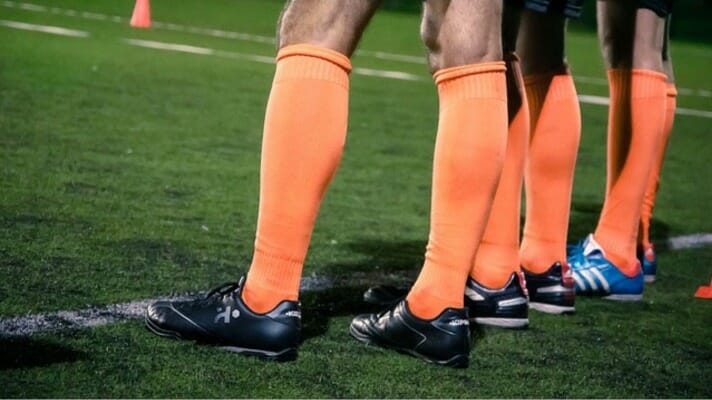
Are you looking for a sporty shoe that will help you maximize your performance on the soccer field?
Soccer cleats are perfect, combining technology and design to provide the kind of grip, protection, and agility necessary when playing competitive soccer.
This guide will cover all the different types of cleats, from molded studs to Eco-friendly, and help you decide which option is best for your game.
Whether it’s turf or artificial grass – this guide has everything you need to know about soccer cleat selection!
What are the Different Types of Soccer Cleats in the Market?
There are 5 types of soccer cleats available in the market today which are explained below.
- Firm Ground Soccer Cleats (FG)
- Soft Ground Soccer Cleats (SG)
- Artificial Ground Soccer Cleats (AG)
- Turf Soccer Cleats (TF)
- Indoor Ground Soccer Cleats
1. Firm Ground Soccer Cleats
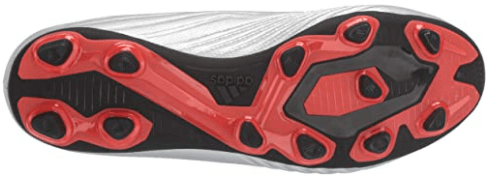
Firm ground soccer cleats are best for most types of natural grass fields. These cleats have a mixture of conical and bladed studs that balance stability, traction, and agility.
Bladed studs on the shoe’s sole are longer than conical studs and provide more grip when making quick direction changes or sudden stops.
Conical studs give players a better level of comfort due to their rounded shape, which distributes pressure evenly across the foot.
The combination of both types offers maximum performance in any weather condition, so you can always be at your best on game day!
Firm ground cleats typically have a mixture of both conical and bladed studs.
The conical studs are rounded and provide a balanced distribution of pressure across the foot, while the bladed studs are longer and offer greater grip when making quick turns or sudden stops.
FG soccer cleats are best for most natural grass fields and any weather, from sunny to rainy.
2. Soft Ground Soccer Cleats
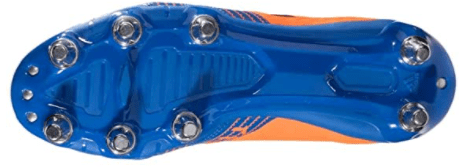
Soft-ground soccer cleats are designed for wet and muddy fields. They have longer, more aggressive studs that give players extra grip on slippery surfaces.
The increased number of studs in the sole of the shoe also helps to reduce the overall pressure when running or to turn quickly.
Traction on soft ground is the main advantage of metal studs. These are essential for players to have adequate traction in wet natural grass fields, helping them stay upright and avoid needless falls or collisions.
Metal studs may appear hazardous but they help protect players from injuries in wet weather conditions.
Metal studs, while more expensive than plastic ones, have greater strength and durability.
When they eventually wear out, replacing them is as easy as buying a new pair of studs – no need to replace the whole cleat pair. This applies especially if you choose mid- or high-priced options.
adidas soccer cleats are best used in wet and muddy weather conditions. The extra studs provide the grip and stability necessary to avoid slipping on slick surfaces.
3. Artificial Ground Soccer Cleats

Artificial ground soccer cleats are designed to provide maximum grip on synthetic surfaces.
These cleats have shorter, rubber studs than their soft-ground counterparts, allowing them to dig into the Artificial ground and provide players with excellent traction.
The sole also features a rubber outsole that cushions when running and turning on harder surfaces.
AG soccer cleats are perfect for those playing regularly on artificial surfaces, offering great protection without sacrificing performance or agility levels.
They are typically lighter in weight than traditional cleats providing increased speed and enhanced acceleration capabilities.
AG soccer cleats can be used in all types of weather conditions but may require extra attention from time to time to keep them clean and free from dirt build-up. Cleaning the cleats after each use is recommended to ensure they remain in top condition for longer.
Rubber studs do not penetrate the artificial ground as easily as they do on natural surfaces, making them a better choice for use on AG fields.
The rubber studs provide excellent traction on synthetic surfaces without the risk of damaging the turf, so players can enjoy the game without damage to the playing surface.
4. Turf Soccer Cleats (TF)
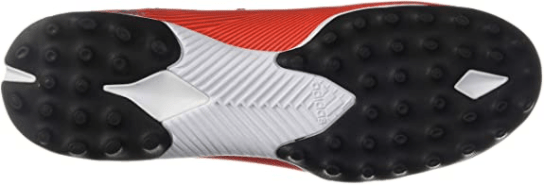
Artificial ground (AG) is a playing surface made from polyethylene (PE), while synthetic turf is made from a variety of materials such as rubber and plastic.
The main difference between the two types of surfaces is that turf provides greater friction for athletes compared to the artificial ground (AG).
Turf also requires more frequent maintenance than artificial turf (AG), as it needs to be watered and mowed regularly.
Artificial turf (AG) is a more durable surface that requires less maintenance, making it ideal for professional venues.
Turf soccer cleats are designed to provide superior grip and traction on artificial surfaces like synthetic turf.
They feature shorter studs than traditional cleats, which help to prevent slippage while providing a comfortable ride.
Turf shoes have shorter, harder studs. They provide maximum grip on artificial surfaces and dig into the turf, providing players with excellent traction.
TF soccer cleats provide great traction on artificial surfaces. The shorter studs and rubber outsole offers maximum grip with reduced risk of slipping or sliding.
5. Indoor Soccer Cleats
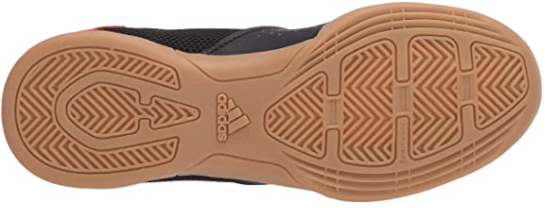
Indoor soccer shoes are designed with a flat sole perfect for playing on indoor surfaces such as hardwood courts, basketball courts, and other sports.
They feature a low-profile design that allows players to move quickly without worrying about slipping or sliding on the court.
The soles of these shoes are also usually made of rubber or polyurethane, which provides superior grip and cushioning while playing indoors.
Indoor soccer shoes offer great breathability due to their lightweight construction and mesh upper material.
This helps keep your feet cool and dry even during intense play, allowing you to focus more on the game.
They offer great breathability and superior grip and cushioning, making them perfect for athletes looking to increase their speed and agility while playing indoors.
moreover, cleaning the cleats after each use is recommended to ensure that they remain in top condition for longer periods.
Indoor soccer shoes are ideal for those who want a competitive edge while enjoying maximum comfort on the court.
Difference between Outdoor and Indoor Cleats:
Indoor soccer shoes are designed with a flat rubber sole, making them great for playing on indoor surfaces such as gym floors or basketball courts.
This type of cleat typically has non-marking soles to prevent scratches and damage to the surface you’re playing on.
The upper part is generally made from lightweight materials that provide flexibility and airflow while cushioning your feet during movement.
Outdoor soccer shoes are designed to provide the maximum performance and protection required for playing on grass, artificial turf, or hard ground.
The types of cleats range from molded studs to removable cleats that can be customized according to your field type.
They come with various uppers ranging from synthetic leather, mesh, and kangaroo leather, as well as cushioning in the midsole for added comfort.
Conclusion
When choosing a soccer cleat, you must consider the types of surfaces you’ll be playing on and the weather conditions you’re likely to encounter.
Soft ground cleats are best used in wet and muddy conditions, while AG soccer cleats offer a great grip on synthetic turf.
Indoor soccer cleats feature a flat sole that allows for superior grip and cushioning when playing indoors.
Whatever type of cleat you choose, clean them thoroughly after each use for maximum performance. You can ensure your game reaches its full potential with the right pair of shoes!
FAQs
What are molded cleats?
Molded cleats are created using a special process known as injection molding. This involves pouring molten rubber into a metal mold and then shaping the cleat around an internal metal insert. The resulting cleats offer superior grip and traction on artificial surfaces, while still being lightweight and comfortable. They also provide increased cushioning due to their flexible construction. Additionally, molded cleats are durable and can withstand wear and tear from frequent use.
What types of studs do turf soccer cleats have?
Turf soccer cleats typically have short plastic or rubber studs that are designed to provide superior grip and traction on turf surfaces. The shorter length of the studs helps prevent slipping while making sharp turns, as well as providing cushioning when running quickly.
Are AG soccer cleats suitable for all types of weather conditions?
Yes, AG soccer cleats can be used in all weather conditions but may require extra attention from time to time when keeping them clean and free from dirt build-up.


